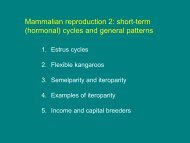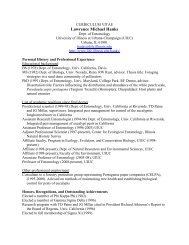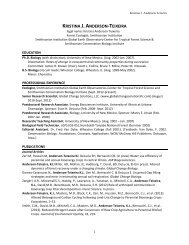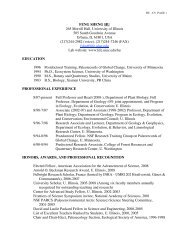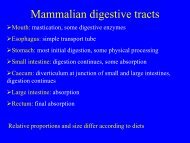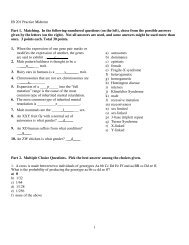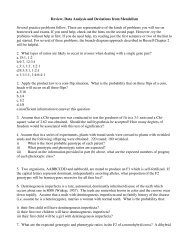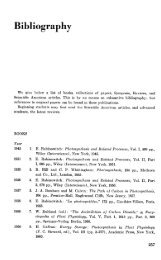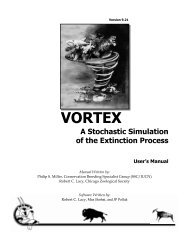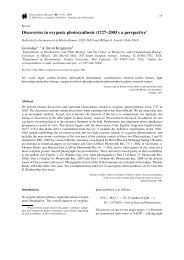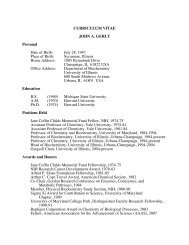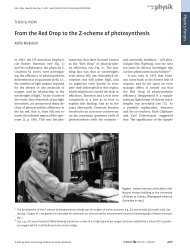Food webs and networks: the architecture of biodiversity
Food webs and networks: the architecture of biodiversity
Food webs and networks: the architecture of biodiversity
Create successful ePaper yourself
Turn your PDF publications into a flip-book with our unique Google optimized e-Paper software.
<strong>Food</strong> <strong>webs</strong> <strong>and</strong> <strong>networks</strong>: <strong>the</strong> <strong>architecture</strong><br />
<strong>of</strong> <strong>biodiversity</strong><br />
<strong>Food</strong> <strong>webs</strong> provide a quantitative framework to link community<br />
structure (i.e., community ecology) with fluxes <strong>of</strong> energy <strong>and</strong><br />
material (i.e., ecosystem ecology) <strong>and</strong> <strong>the</strong>refore reconcile<br />
<strong>biodiversity</strong> with ecosystem function.<br />
Networks focus on specific species interactions (commonly<br />
mutualistic interactions) that can also be diagrammed as <strong>webs</strong> <strong>of</strong><br />
links among species.
<strong>Food</strong> <strong>webs</strong>: <strong>the</strong> history<br />
• Study <strong>of</strong> feeding relations in communities originated with Elton<br />
(1923, 1927)<br />
• Described <strong>the</strong> ‘pyramid’ <strong>of</strong> numbers, or biomass. He<br />
hypo<strong>the</strong>sized that this occurred because predators have to be<br />
larger than prey in order to subdue <strong>the</strong>m.<br />
• Elton’s work forshadowed ideas <strong>of</strong> interaction strength, however<br />
idea <strong>of</strong> energetics didn’t feature until advent <strong>of</strong> ecosystem ecology<br />
in 1930s
Trophic efficiency hypo<strong>the</strong>sis<br />
Introduced by Lindeman (1942)<br />
Thermodynamics dictates food chain<br />
length <strong>and</strong> biomass distributions<br />
because only a fraction <strong>of</strong> energy<br />
(
Jenkins et al (1992) Test <strong>of</strong> trophic efficiency hypo<strong>the</strong>sis<br />
If efficiency <strong>of</strong> energy transfer across trophic levels primarily<br />
determines food chain length <strong>the</strong>n experimental manipulations <strong>of</strong><br />
productivity might influence food chain length<br />
Tree hole experimental system<br />
<strong>Food</strong> from decomposing litter<br />
supports mosquito, dragonfly<br />
larvae <strong>and</strong> tadpoles<br />
Simulate tree holes with<br />
buckets
Treatments:<br />
add litter to natural amounts (938 g/m 2 /yr),<br />
0.1x natural<br />
0.01 x natural.<br />
Found that decreased productivity resulted in decreased number <strong>of</strong><br />
coexisting species, decreased number <strong>of</strong> trophic links <strong>and</strong><br />
maximum food chain length:<br />
After 48 weeks:<br />
Natural litterfall treatments: 4 spp, 5 links, 2.75 spp chains<br />
10 % natural litterfall: 3 spp, 3 links, 2.5 spp chains<br />
1 % natural litterfall: 1.5 spp, 1.5 links, 2 spp chains
Population stability hypo<strong>the</strong>sis<br />
Elton: simple food <strong>webs</strong> tend to be less stable than complex ones?<br />
More prone to extinctions (e.g. isl<strong>and</strong> communities)?<br />
Pest outbreaks (e.g. agricultural communities)?<br />
Generalist predators <strong>and</strong> herbivores have more stable populations?<br />
Tests developed by Cohen, May, Pimm, <strong>and</strong> Lawton in 1970s to<br />
predict whe<strong>the</strong>r differences in web structure could influence <strong>the</strong>ir<br />
stability (<strong>and</strong> exp<strong>and</strong>ed since <strong>the</strong>n)<br />
One o<strong>the</strong>r hypo<strong>the</strong>sis out <strong>the</strong>re…
How do we characterize food web structure?
C=0.3 C=0.4<br />
Connectance (c): A measure <strong>of</strong> <strong>the</strong> number <strong>of</strong> links (L) or<br />
connections between species (S) expressed as a proportion <strong>of</strong><br />
maximum connectance<br />
Maximum connectance = S(S-1)/2<br />
c = L/[S(S-1)/2]
Linkage density (L/S): average number <strong>of</strong> feeding links per sp.<br />
Most important metric <strong>of</strong> <strong>the</strong> food web? Variability in L/S is<br />
called <strong>the</strong> ‘degree distribution’ (frequency distn <strong>of</strong> interactions).<br />
Compartmentation: Extent to which a food web contains<br />
relatively isolated sub<strong>webs</strong> - calculated by measuring <strong>the</strong><br />
number <strong>of</strong> species that interact with species pairs versus single<br />
species<br />
Trophic level: In complex <strong>webs</strong> = average number <strong>of</strong> links + 1<br />
from base to species <strong>of</strong> interest
Omnivory: One predator feeding on prey located at different<br />
trophic levels<br />
Same-chain<br />
omnivory<br />
Different-chain<br />
omnivory<br />
Life-history omnivory is<br />
common: different size/age<br />
classes <strong>of</strong> an organism feed<br />
at different trophic levels.<br />
Tadpoles: herbivorous<br />
Frogs: insectivorous
Cycles <strong>and</strong> loops: Connectance patterns when species have reciprocal<br />
feeding relations.<br />
Cycle = Species A eats B <strong>and</strong> B eats A (e.g. wasps <strong>and</strong> spiders).<br />
Loop = Species A eats B, B eats C <strong>and</strong> C eats A<br />
Rigid circuit properties: Overlaps in prey consumption among<br />
predators Predators<br />
Overlap in prey consumption<br />
among predators:<br />
Prey<br />
Links here do not indicate predator-prey relationship<br />
but indicate which <strong>of</strong> <strong>the</strong> four predators compete for <strong>the</strong><br />
same prey taxon (ie. 2 <strong>and</strong> 4 do not share prey)
Are food <strong>webs</strong> interval?<br />
• Cohen suggested that <strong>of</strong>ten yes, overlaps among predators in <strong>the</strong><br />
prey that <strong>the</strong>y consume can be represented by a series <strong>of</strong> line<br />
segments arranged in a single dimension. Argued that this means<br />
that a single niche dimension is sufficient to describe feeding<br />
relations among predators.<br />
An interval food web: what does this<br />
represent?<br />
Some dimension<br />
Prey consumed by<br />
different predators
Do cycles <strong>and</strong> loops occur in nature?<br />
Polis (1991) - a skeptic <strong>of</strong> food web <strong>the</strong>ory - characterized<br />
desert food <strong>webs</strong> in great detail: found evidence that 2 or 3 sp<br />
loops occur in systems with size-dependent predation. Role<br />
reversals between predators <strong>and</strong> prey may not be that<br />
uncommon…<br />
How constant is connectance?<br />
Seems to depend on how detailed are <strong>the</strong> described <strong>webs</strong>.<br />
Miss out rare species with few connections?? May be<br />
constant over fairly broad range <strong>of</strong> species richness (but see<br />
Dunne example later)
Pitcher plant food web from Beaver (1985) in Ricklefs: Economy <strong>of</strong> Nature.<br />
connectance 0.33 0.29 0.24
What kind <strong>of</strong> food web configurations promote stable<br />
equilibrium population dynamics <strong>of</strong> species (coexistence)?<br />
May (1973), <strong>and</strong> Pimm <strong>and</strong> Lawton (1977, 1978) used multispecies<br />
Lotka-Volterra models to assess stability <strong>of</strong> food <strong>webs</strong> (see Morin pp<br />
168-173 <strong>and</strong> appendix).<br />
dX i /dt = X i (b i + ∑aij X j )<br />
Where X i is abundance <strong>of</strong> species i<br />
b i is per capita growth rate <strong>of</strong> species i<br />
a ij is <strong>the</strong> effect <strong>of</strong> species j on species i (<strong>and</strong> intraspecific densitydependent<br />
effects)
Imagine interactions between species at different trophic levels.<br />
2<br />
4<br />
3<br />
2<br />
1<br />
4<br />
3<br />
1<br />
1 2 3 4<br />
1 - - 0 0<br />
2 + 0 - 0<br />
3 0 + 0 -<br />
4 0 0 + 0<br />
1 2 3 4<br />
1 - 0 - 0<br />
2 0 - - 0<br />
3 + + 0 -<br />
4 0 0 + 0<br />
Matrix entries represent percapita<br />
effects <strong>of</strong> one species on<br />
ano<strong>the</strong>r (a i,j )<br />
Zeros are no connections - no<br />
direct effects<br />
+ are positive effects<br />
mutualisms or prey supplying<br />
energy to predators<br />
- are negative effects<br />
predation (or densitydependent<br />
population growth<br />
<strong>of</strong> basal species)
Pimm <strong>and</strong> Lawton: Solve equilibrium population sizes <strong>of</strong> n<br />
species, given particular values <strong>of</strong> a i,j<br />
Evaluate stability <strong>of</strong> food <strong>webs</strong> by adding a disturbance that shifts<br />
population size <strong>of</strong> focal species away from <strong>the</strong> equilibrium.<br />
Repeat this exercise many times using different (r<strong>and</strong>omly<br />
drawn) values <strong>of</strong> a i,j from a normal distribution<br />
<strong>Food</strong> <strong>webs</strong> could be unstable - perturbation leads to extinction <strong>of</strong><br />
a species<br />
or<br />
Stable. If stable, measure time to return to equilibrium popn sizes.<br />
Slow return would leave spp more prone to extinction (some<br />
species at low population size)
Results <strong>of</strong> <strong>the</strong>se models are difficult to interpret!<br />
• Lawton <strong>and</strong> Pimm: short chains were more stable than long chains<br />
(quicker return times), but re-analysis suggests that this may be a<br />
consequence <strong>of</strong> greater frequency <strong>of</strong> density-dependent selfregulation<br />
not food chain length<br />
• <strong>Food</strong> <strong>webs</strong> containing omnivory were frequently unstable. But<br />
those that were stable were more stable than similar chains without<br />
omnivory… What does that mean??!<br />
Conclude: stability in r<strong>and</strong>om <strong>webs</strong> depends on web construction<br />
However stability is strongly dependent on <strong>the</strong> distribution <strong>of</strong><br />
interactions strengths. Assumption <strong>of</strong> normality is flawed.
Lawler <strong>and</strong> Morin (1993), Lawler (1993) tests <strong>of</strong> population<br />
stability hypo<strong>the</strong>sis:<br />
If population dynamics are less stable in long food chains <strong>the</strong>n<br />
experimental manipulations <strong>of</strong> food chain length should affect<br />
variability <strong>of</strong> population dynamics<br />
Population fluctuations <strong>of</strong> protists in food chains <strong>of</strong> bacteria --<br />
bactivorous protist -- omnnivorous protist or protistivorous protist<br />
- Found that in 3 <strong>of</strong> 4 food <strong>webs</strong> <strong>the</strong> abundance <strong>of</strong> bactivorous<br />
protists varied more when <strong>the</strong> bactivore occurred in longer than<br />
shorter food chains<br />
- Omnivorous protists showed less population fluctuation than<br />
protists just feeding on one trophic level. No evidence that presence<br />
<strong>of</strong> an omnivore increased fluctuations <strong>of</strong> o<strong>the</strong>r species
Species fluctuations in food <strong>webs</strong> are highly species specific.<br />
This suggests that life-history traits <strong>of</strong> individual species are<br />
important <strong>and</strong> that generalizations will be dependent upon many<br />
replicated studies…<br />
Lawler constructed microcosms <strong>of</strong> bacteria prey <strong>and</strong> 2 higher<br />
trophic levels <strong>of</strong> protists (protist predator <strong>and</strong> protist prey species).<br />
She looked at how adding different numbers <strong>of</strong> protist predatorprey<br />
pairs to <strong>the</strong> microcosm influenced <strong>the</strong> frequency <strong>of</strong> extinctions<br />
<strong>of</strong> protist species<br />
- Webs consisting on 1 species pair were stable<br />
- In <strong>webs</strong> containing 2 species pairs extinctions occurred in 2.5 %<br />
<strong>of</strong> population<br />
- In <strong>webs</strong> with 4 species pairs extinctions occurred in 22 % <strong>of</strong><br />
populations
Measuring interaction strength:<br />
Lawton/Pimm/May in <strong>the</strong>ir r<strong>and</strong>om food <strong>webs</strong> varied interaction<br />
strength r<strong>and</strong>omly <strong>and</strong> gave interaction strengths a normal<br />
distribution.<br />
May not be realistic? What is <strong>the</strong> distribution <strong>of</strong> IS?<br />
Paine again (1992)… Looked at how interaction strengths were<br />
distributed in his rocky intertidal community. Measured relative<br />
strength <strong>of</strong> a predator (grazer) on prey (algae)<br />
(Treatment density - Control density)/Control density<br />
Divide this by predator density to give per capita predator effect<br />
on prey = Interaction Strength (I)<br />
Can I be positive? Think Paine 1966!
Most tests <strong>of</strong> IS just look at pairs <strong>of</strong> species - overlook potential<br />
indirect effects?<br />
Paine: set up multiple exclosures from which only one <strong>of</strong> a<br />
community <strong>of</strong> grazing invertebrates was removed.<br />
Looked at <strong>the</strong> impact <strong>of</strong> removal on growth <strong>of</strong> a brown alga.<br />
Argued that this is <strong>the</strong> key interaction in <strong>the</strong> system. In <strong>the</strong><br />
absence <strong>of</strong> grazing algae dominates <strong>the</strong> system (like Kelp…)<br />
A species with a strong IS would prevent algal growth <strong>and</strong> shift<br />
composition <strong>of</strong> <strong>the</strong> community…ie a major change in food web<br />
structure
Paine found that most interactions are weak - i.e. algae did not<br />
respond strongly to removal <strong>of</strong> most grazers, however <strong>the</strong>re are a<br />
few very strong interactions (per capita effects <strong>of</strong> removal <strong>of</strong> an<br />
urchin <strong>and</strong> a chiton species).<br />
Interactions strengths heavily skewed toward weak interactions.<br />
Only 2 herbivores had strong negative effects on alga<br />
(Hedophyllum).
Recently, resurgence <strong>of</strong> interest in ‘network <strong>the</strong>ory’<br />
See papers by Jordi Bascompte <strong>and</strong> Jason Tyliankus<br />
Emphasis on quantitative metrics <strong>of</strong> interaction strength eveness<br />
<strong>and</strong> connectance<br />
Are connection patterns r<strong>and</strong>om, nested (specialists are a<br />
subset <strong>of</strong> generalists) or compartmentalized?<br />
How does phylogenetic similarity influence feeding relations?<br />
Focus on specific interactions - mutualisms, parasitism ra<strong>the</strong>r<br />
than whole community linkage.
Tyliankus et al. (2007) How<br />
does habitat modification<br />
affect food web structure?<br />
Studies <strong>of</strong> habitat modification usually concentrate on change or<br />
loss <strong>of</strong> species.<br />
Also expect changes in feeding relationships unrelated to species<br />
richness.<br />
Changes in feeding relationships could influence community<br />
stability over long timescales
Used quantitative measures <strong>of</strong> range <strong>of</strong> foodweb properties<br />
Generality: ave host spp per parasitoid; LD: linkage density;<br />
Compartments: # unconnected sub<strong>webs</strong>; Vulnerability: parasitoids<br />
per host; Eveness: eveness <strong>of</strong> interaction strengths; Connectance:<br />
linkage density/sp; Parasitism: proportion hosts parasitized
Parasitoid abundance on top; host abundance on <strong>the</strong> bottom<br />
Linkage width indicates frequency <strong>of</strong> interaction
Many more specialized interactions in modified habitat (rice)
Quantitative measurements <strong>of</strong> food web structure reveals<br />
differences in organization that would not be apparent from<br />
qualitative descriptors (species richness)<br />
Agricultural systems were dominated by a single trophic<br />
interaction (one bee, one parasitoid)<br />
Overall parasitism was highest in <strong>the</strong> modified habitats - stronger<br />
top-down control (consistent with literature)<br />
Important implications for pollination services (solitary bees) <strong>and</strong><br />
biological control (wasps as predators <strong>of</strong> pests)
Can we use food web <strong>the</strong>ory to evaluate how robust communities<br />
are to species loss?<br />
Dunne et al. (2002) Ecology Letters 5:558<br />
Motivated by network <strong>the</strong>ory that explores how complex <strong>networks</strong><br />
(eg. Power grid, WWW, neural <strong>networks</strong>) are influenced by node<br />
loss.<br />
However most <strong>networks</strong> show scale free distributions (linkage<br />
density <strong>of</strong> nodes follows a power-law relationship) <strong>and</strong> few nodes<br />
are highly connected. <strong>Food</strong><strong>webs</strong> in general show more uniform<br />
connectivity.<br />
Used a set <strong>of</strong> 16 well characterized food <strong>webs</strong> differing in<br />
richness <strong>and</strong> connectedness to explore how robust <strong>the</strong>y are to<br />
secondary extinctions following species elimination.
Are <strong>the</strong>re ‘rivet-like thresholds’ where enough primary extinctions<br />
result in community collapse?<br />
S= trophic species (share <strong>the</strong> same predators/prey)<br />
Res = % <strong>of</strong> taxa identified; O = fraction <strong>of</strong> species that are omnivores
For each food web simulate extinction by sequentially removing<br />
(trophic) species according to various criteria (e.g., r<strong>and</strong>om, most<br />
connected spp, least connected spp).<br />
Measured stability as: number <strong>of</strong> potential secondary extinctions,<br />
which would occur if a species lost all its prey items.<br />
“Robustness”: How many species do you need to remove to<br />
eliminate half <strong>of</strong> all species in <strong>the</strong> web (secondary extinctions)<br />
Correlated robustness against food web metrics (S, connectedness,<br />
omnivory)
As expected, more impact on communities <strong>of</strong> eliminating highly<br />
connected species (more secondary extinctions)…but<br />
<strong>Food</strong> web robustness strongly influenced by connectance<br />
Robustness here<br />
is proportion <strong>of</strong><br />
primary spp<br />
removals<br />
necessary to<br />
generate 50%<br />
extinction from<br />
food web.
Can we use food web <strong>the</strong>ory to evaluate how robust<br />
communities are to species loss (2)?<br />
Staniczenko et al. (2010) Structural dynamics <strong>and</strong> robustness <strong>of</strong><br />
food<strong>webs</strong>. Ecology Letters13:891-899<br />
Follow up to Dunne et al. (2002) – many same methods<br />
Many examples where species change diet when competition for<br />
prey items is relaxed (why??).<br />
Asked What are <strong>the</strong> consequences <strong>of</strong> incorporating predator-prey<br />
“rewiring” for food web robustness?
Imagine a foodweb where species 4 depends on prey 1<br />
Competition for<br />
prey <strong>of</strong> species<br />
4 reduced<br />
Remove species 4<br />
<strong>Food</strong> web is rewired<br />
as sp 6 consumes sp<br />
1
Results<br />
Fraction <strong>of</strong> sp removals<br />
until no spp remains<br />
PIR = proportional<br />
increase in robustness
Staniczenko et al. argue that cannot predict outcome <strong>of</strong> species<br />
loss using a static food web<br />
Compensatory effects have potentially strong impacts on food<br />
web robustness.<br />
Robustness <strong>the</strong>n depends on overlap spp that can shift diet<br />
when prey species is removed (ra<strong>the</strong>r than S or c) .
Dunne/Staniczenko work highlights limitation <strong>of</strong> two approaches<br />
to exploring foodweb stability<br />
Lotka-Volterra approach (May, Pimm, Lawton, Morin)<br />
- per capita effects difficult to parameterize with emprical data<br />
- limited in <strong>the</strong> trophic species richness that can h<strong>and</strong>le<br />
- cannot portray complex (predictable?) topology <strong>of</strong> food <strong>webs</strong><br />
Structural approach (Dunne <strong>and</strong> later papers)<br />
- tractable to empirical data for large numbers <strong>of</strong> taxa<br />
- lack information on population size, dynamics<br />
- cannot quantify species links as energy flow or interaction<br />
strength
Future <strong>of</strong> food web research (Thompson et al. in press)<br />
Utility <strong>of</strong> food web research is linking community structure to<br />
ecosystem function. Need to:<br />
Incorporate energy flux into food <strong>webs</strong> to evaluate ecosystem<br />
function<br />
Link individual traits to food web structure – for example size or<br />
metabolic varition<br />
Incorporate temporal <strong>and</strong> spatial variation in food web structure<br />
Predict impacts <strong>of</strong> <strong>biodiversity</strong> loss or invasion on ecosystem<br />
function
Summary<br />
<strong>Food</strong> web studies explore how trophic relationships influence <strong>the</strong><br />
stability <strong>of</strong> communities. When linked to explorations <strong>of</strong> energy<br />
flow <strong>the</strong>y can (could) provide a framework for examining top<br />
down <strong>and</strong> bottom up effects in communities<br />
Early modeling efforts made unrealistic assumptions about <strong>the</strong><br />
distribution <strong>of</strong> interaction strengths in communities. The<br />
distribution <strong>of</strong> strengths is now better understood but<br />
application to food <strong>webs</strong> is limited.<br />
<strong>Food</strong> web studies provide opportunities to predict how species<br />
losses propagate through communities <strong>and</strong> influence community<br />
stability <strong>and</strong> ecosystem services.



